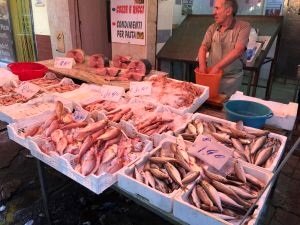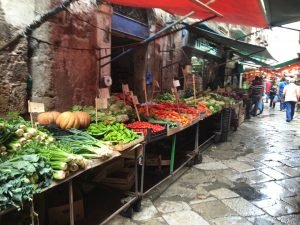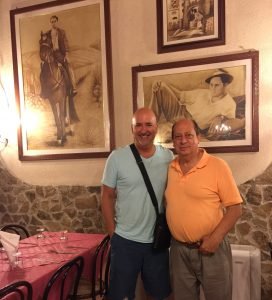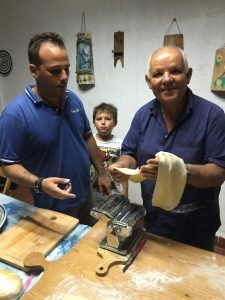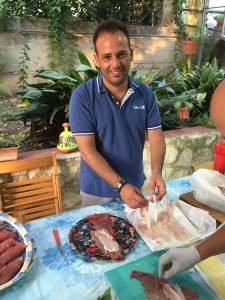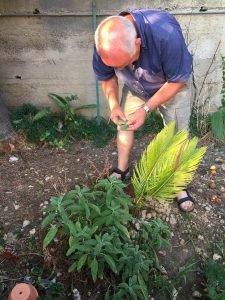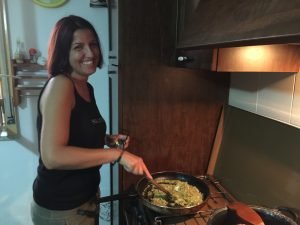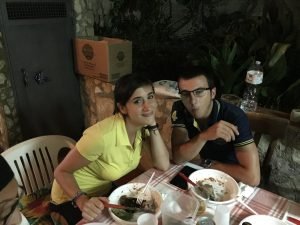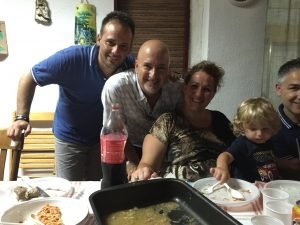A Culinary Dream Come True
The first time I visited Italy, I knew I wanted to cook there. At the top of my list of accomplishments was a desire to gather ingredients from a market located in the birthplace of my grandfather, and prepare a meal. The little town of Montelepre, located near Palermo, sits just high enough to touch the clouds that hang low as the hot African heat cools down over the Mediterranean Sea. Many Americans may not have heard of the town. But to Sicilians, it’s the birthplace of the famous Sicilian bandit, Salvatore Giuliano. He rose to prominence in the disorder which followed the Allied invasion of Sicily in 1943. Known as the Sicilian Robin Hood, this flamboyant, high-profile outlaw became a local powerbroker in Sicilian politics between 1945 and 1948. Yet, he was gunned down in 1950. While visiting my great grandmother’s grave in the local crematory, I witnessed a steady flow of people, stopping to see the Sicilian bandit’s grave site. This mythical figure still holds a sort of Elvis/Graceland effect on the Sicilian people.
After many years of visiting and receiving delicious Sicilian meals served by my cousins, I declared it was my turn to cook the Sunday dinner. I welcomed my relatives’ take on some of the courses we served when we performed the “How Italian Food Conquered the World” dinner for Ciao Bella Productions, our dinner theater company.
First, we visited the famous Palermo outdoor market, Ballaro’, where we purchased eggplant and cheeses to create the melanzane involtini (eggplant rollatini). Now, this market doesn’t have the grandeur and style of other markets in larger cities like Florence or Rome. But, to listen and watch the vendors bark out their produce features, and their exchange with the hordes of visitors that shop there daily, it is theater, nonetheless. My eyes feasted on booth after booth of the most incredible array of foods, all fresh and locally sourced every day. Tables spilled over with colorful, beautiful and sometimes unusually shaped fruits and vegetables. Take the long, thin zucchini called zucchine di tenerumi that resembles a lengthy, crooked walking stick.
Lovely cuts of meat and a variety of sausages spread out over meat counters. Butchers, like characters from a Federico Fellini film, guard their goods, cleaver in one hand, cigarettes dangling from their mouths, ashes dropping who knows where. No American obsessions with cleanliness here. Just people food shopping as they have for hundreds of years.
Onto the fishmongers. Seafood simply can’t be matched anywhere in the world with the Mediterranean bounty of fish plucked from the sea each day. The clams are so fresh you can actually watch them maneuver around in their water-filled containers. An impressively giant swordfish (pesce spada) with its long sword pointing to the sky, lays on the counter. The butcher (or fish cutter) custom-cuts the swordfish for his customers, a common practice.
With our prized-filled bags in hand and mission accomplished, we needed a little refreshment. A visit to a nearby gelateria was in order. Sicily has been blessed with the foods of its conquerors and gelato is a perfect example of this. First brought to Sicily by the Arab people, the early forms of this dessert was snow brought down from the mountain and mixed with crushed fruit and honey (today called granite). Hundreds of years later, the first gelato machine was invented in Sicily and helped set this little island on a course to be the best dessert region in all of Italy. Amaretto with biscotti for me, and vanilla and cocoa for Alba. We relaxed and cooled down with a wonderful serving of gelato as we discussed our next task at hand.
We next drove up the mountain to stop at the market where we had called in our order for veal, prosciutto, and Fontina cheese for the Saltimbocca alla Romana. I remembered the butcher, Giuseppe, from last year, as I watched him butcher a chicken for me with great marvel and envy. We grabbed some flour (semolina) and eggs for our fresh pasta and we were ready to cook.
I must admit I was a little nervous taking on the challenge of cooking for my family. When the number of guests reached around 25, I contemplated how we would pull it all together. However, I had plenty of cousins to help, and soon the groove kicked in. Along with the veal and eggplant, I prepared two types of pasta and sauces. First a simple basil marinara with spaghetti. Then, to give tribute to cooking in Sicily, a pistachio cream sauce over fettuccine. Italian cooks commonly use grounded nuts in sauces, and pistachio is often preferred in Sicily. To prepare the veal, Giuseppe, the son-in-law of our hosts Pino and Vita, offered to help roll the veal, ham, Fontina cheese and freshly picked sage (salvia) from Pino’s garden. I then enlisted Pino to finish rolling the pasta and cut the two types. Annalisa and Luciana assisted with the sauces and Vita was right by my side, grilling the veal on the outdoor kitchen stove.
The pistachio cream sauce is simple, but does need a little attention when stirring to prevent the cream and cheese from scorching. Start with olive oil and chopped onions. Add the grounded nuts and cook while stirring. Once the nuts and onions are cooked, add white wine to deglaze the caramelized onion and then add cream and butter. Keep stirring, while adding in the grated cheese. Just before serving, add water from the cooked pasta water to regulate the thickness you prefer.
The Saltimbocca alla Romana is a classic Roman dish. The fresh sage makes this dish do just what the words mean– “jump in the mouth”! Once you have the ingredients rolled together, use a toothpick to keep them in place while cooking. Salt and pepper one side and place that side in flour. Grill on the stove, the floured side first in olive oil and as the veal is almost cooked, add white wine and cook until the alcohol scent is gone. Remove the meat and stir in more flour, if needed to thicken the sauce, and then serve on top.
Typically in Italy, fruit is served after the meal and before the dessert. Earlier, I had picked up a giant watermelon from a street vendor. I cut it in slices and served it on the table.
For dessert, I had previously prepared a sheet of baklava, to pay tribute to the Greeks who contributed a great deal to Italian cooking. I had also made biscotti, prepared in a Tuscan style. This, combined with an amazing torta gelato (ice cream cake) that my cousin brought to the party, completed our feast.
My culinary dream came true when my family and our guests delivered a round of applause for the meal. What started for me many years ago as a desire to cook in Italy, to buy ingredients from the small town my grandfather was born in, culminated in a true cultural event. To gather, prepare, cook and serve my family with all the love that radiates from food, felt like a gift from God.
Blog Posts


